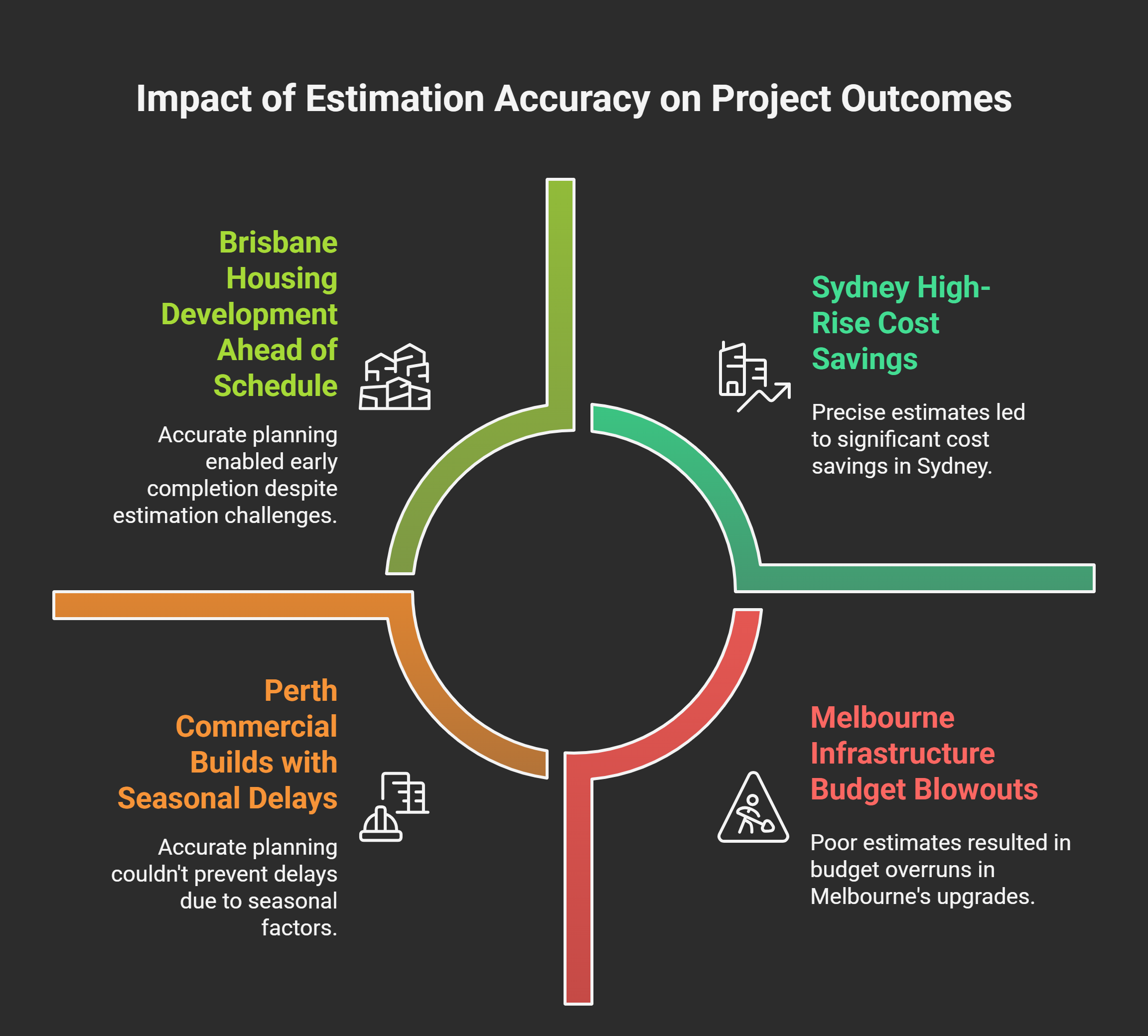Accurate cost planning, scheduling, and resource allocation highlight the importance of estimation in construction. It ensures financial control, reduces project risks, and supports informed decision-making. Reliable estimates align client expectations, guide contractor bidding, and prevent costly overruns that affect nearly 12% of Australian projects annually.

Cost Control
The Importance of Estimation in Construction lies in helping builders control expenses through accurate forecasting and resource planning. By aligning labour, materials, and timelines, teams minimise financial risks and improve project efficiency, ensuring each dollar spent contributes directly to long-term profitability and cost stability.
In Australia, where 30% of projects face cost overruns, the Importance of Estimation in Construction becomes clear. Reliable estimates empower contractors to manage budgets effectively, anticipate price fluctuations, and allocate contingencies wisely, fostering better financial discipline and smoother project execution across diverse construction environments.
Accurate Planning
Accurate planning starts with recognising the importance of estimation in construction, where timelines, resources, and milestones are clearly defined. Skilled estimators align every phase with available manpower and materials, ensuring seamless coordination across trades and reducing risks tied to project complexity.
Industry reports show that well-estimated projects, including estimate jobs in construction, face 20% fewer schedule disruptions. By factoring in local weather patterns, site accessibility, and regulatory steps, accurate estimation transforms planning from guesswork into strategy, fostering efficiency and accountability across all construction stages.
Optimal Resource Allocation
Efficient project delivery depends on clear forecasting. The Importance of Estimation in Construction lies in aligning manpower, equipment, and timelines through precise planning. Skilled estimators assess types of construction estimates to ensure resources meet demand, as seen in Victoria’s regional builds where strategic allocation reduced idle machinery and boosted workflow accuracy.
Accurate estimation also supports sustainability by minimising waste and improving asset use. Australian contractors applying data-driven estimation methods have achieved up to 25% efficiency gains, demonstrating how strong estimation practices enhance productivity. Projects like Adelaide’s bridge works prove that effective forecasting ensures seamless resource utilisation and environmental balance.
Here’s a table outlining key resource types and their estimation benefits:
| Resource Type | Estimation Benefit | Example Impact |
| Labour | Matches skill levels to tasks | Reduced overtime in urban builds |
| Materials | Forecasts quantities accurately | Minimised waste on large-scale jobs |
| Equipment | Schedules usage to avoid conflicts | Faster completion in remote areas |
Better Decision-Making
Accurate forecasts enable better decision-making by identifying potential risks and opportunities early in the project lifecycle. The importance of estimation in construction lies in empowering managers to compare options, like alternative materials or design changes; that optimise quality and cost efficiency for sustainable outcomes.
Collaborative estimating fosters informed discussions among contractors, architects, and engineers, aligning project goals with compliance and budget expectations. Studies by the Australian Construction Industry Forum show data-driven estimates reduce design revision costs by up to 18%, proving their role in supporting consistent and confident decision-making.
Attracting Investors and Clients
Accurate projections form the foundation for securing funding and investor confidence. The importance of estimation in construction lies in presenting realistic budgets and timelines that prove operational control. In Australia’s commercial sector, data shows projects with detailed estimates attract 30% more private investment due to reduced perceived risk.
Transparent figures and structured forecasts help builders earn client trust while showcasing accountability. Estimation also supports partnership development, as seen in Melbourne and Brisbane projects where precise financial modelling improved stakeholder engagement. Ultimately, strong estimation practices enhance a firm’s credibility and boost long-term investor relationships.
Preventing Contractual Disputes
Clear financial frameworks and defined scopes form the backbone of trust in construction projects. The importance of estimation in construction ensures every stakeholder understands obligations, limiting conflicts. Reports show that detailed pre-contract estimates can cut legal disputes by up to 30%, strengthening collaboration and accountability across teams.
When estimators apply structured methodologies like cost breakdown analysis and risk forecasting, they pre-empt misinterpretations. The importance of estimation in construction supports transparent documentation, helping contractors and clients align expectations. Australian builders who prioritise data-driven estimation consistently achieve smoother project delivery and stronger long-term partnerships.
Healthy Competition in Tenders
Balanced projections promote fairness in Australia’s tender system, ensuring bids reflect genuine project scope. The importance of estimation in construction empowers contractors to submit competitive yet sustainable offers. According to Infrastructure Australia, transparent estimates cut tender disputes by 22%, boosting collaboration and trust among stakeholders.
Such accuracy drives innovation and healthy competition across the sector. Builders using digital estimating tools and value-based frameworks focus on efficiency, not price wars. The importance of estimation in construction ultimately strengthens credibility, supporting long-term industry growth and consistent project outcomes nationwide.
- Evaluate project scope thoroughly.
- Analyse market rates for materials and labour.
- Incorporate risk assessments.
- Review historical data from similar jobs.
- Finalise with team consultations for accuracy.
Improved Final Quality
Improved final quality stems from detailed planning that anticipates every construction variable. The importance of estimation in construction appears in fewer defects and smoother execution. Research shows projects with accurate estimates record 18% higher quality ratings, highlighting better coordination, durability, and long-term performance outcomes.


